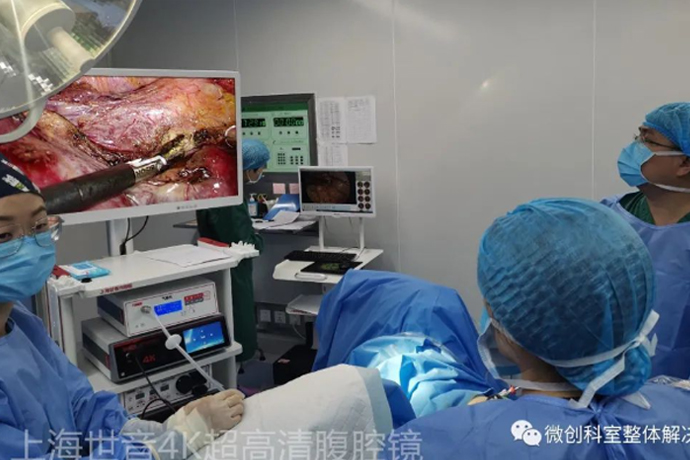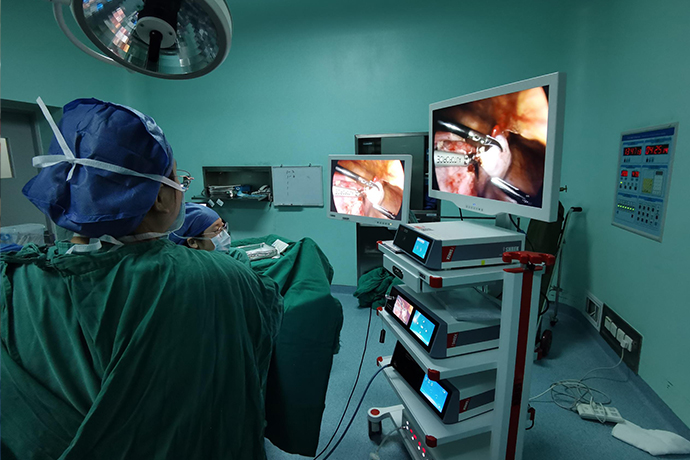[Gynecological Laparoscopy] 4K Laparoscopic Cervical Cancer Radical Surgery
Release time: 19 Jul 2023 Author:Shrek
Cervical Cancer Definition
1. What is cervical cancer?
Cervical cancer is a malignant tumor that occurs in the epithelial tissue of the cervix. Persistent infection of high-risk human papillomavirus (HPV) is the main cause of cervical cancer.

Symptoms of Cervical Cancer
2. What are the symptoms of cervical cancer? the
Cervical cancer often has no obvious symptoms in the early stage. As the disease progresses, symptoms such as irregular vaginal bleeding and vaginal discharge gradually appear.
Risk factors associated with cervical lesions
3. What risk factors are associated with cervical lesions?
The main pathogenic factor of cervical cancer is persistent infection of high-risk HPV, and other high-risk factors include:
(1) Family history of cervical cancer and other diseases
(2) Premature sex life
(3) Premature childbirth (before the age of 18)
(4) Are receiving immunosuppressant treatment
(5) Multiple sexual partners or multiple sexual partners
(6) HIV infection
(7) Suffering from other sexually transmitted diseases
(8) Smokers and drug addicts
Cervical Cancer Prevention
4. How to prevent HPV infection in daily life? the
Improve self-protection awareness. Safe sex, correct use of condoms, to avoid sexually transmitted diseases. Promote a healthy lifestyle.
5. Can HPV vaccination prevent cervical cancer?
Can. Women aged 9-45 can be vaccinated against HPV. The earlier the vaccination in this age group, the better the protection effect. Among them, women aged 9-15 are the key population.
Cervical anatomy
The cervix is located in the lower third of the uterus and is composed of dense muscular tissue and two types of epithelium. About 3cm long and 2.5cm wide.
The cervix is the lower part of the uterus. It is a cylindrical, hollow structure that connects with the uterine body through the isthmus and communicates with the vagina through the external opening of the cervix.
The scope of laparoscopic radical resection of cervical cancer includes: uterus, cervix and sacrocardial ligament, some vaginal and pelvic lymph nodes, and selective para-aortic lymph node dissection or sampling.
Compared with open surgery, laparoscopic radical surgery has the following advantages:
1. Minimally invasive abdominal wall trauma and less pain
Especially for obese patients, the probability of postoperative incision fat liquefaction and infection is greatly reduced.
2. Ultra-clear vision and less bleeding
Since the 4K laparoscopic equipment is equipped with a 43-inch or 55-inch super-large display screen, it has a unique magnification function, and can identify the structure of the tissue with 4K pixels ultra-clearly, improving the accuracy of separation and resection. Intraoperative bleeding.
3. Less disturbance to the intestinal tract
Laparotomy requires a padded intestinal tube to expose a large area of the abdominal cavity, while laparoscopic surgery has less interference with the intestinal tract and can avoid damage and stimulation of intestinal tissue to the greatest extent. In addition, patients get out of bed early after surgery, so patients with gastrointestinal Functional recovery is relatively quick.
4. Low postoperative infection rate
During laparoscopic surgery, the abdominal cavity is basically in a semi-closed state, and the contact between the surgical field and the external environment is reduced, so the postoperative infection rate is greatly reduced.
These advantages make laparoscopic radical cervical cancer widely accepted by doctors and patients, and develop rapidly in China. In the future development of laparoscopy, we must pay attention to the principle of no tumor and the improvement of uterine lifting equipment to avoid complications.
Laparoscopic Radical Cervical Cancer--Pelvic Lymph Node Dissection
1. Isolation and dissection of the iliac lymph nodes
2. Separate and dissect the external iliac lymph nodes
3. Separation and dissection of the internal iliac lymph nodes
4. Isolation and dissection of obturator lymph nodes
Cervical cancer is the most common malignant tumor in gynecology, and the vast majority of cervical cancers are caused by persistent infection with high-risk HPV. Although the popularization of vaccines and the effective implementation of tertiary prevention measures for cervical cancer have greatly improved the effectiveness of cervical cancer prevention and control, cervical cancer is still a major disease that seriously endangers women's health. Therefore, strengthening the tertiary prevention of cervical cancer, increasing the popularization rate of cervical cancer vaccine, and early diagnosis and treatment in the early stage of cervical cancer with better treatment effect are particularly critical.
